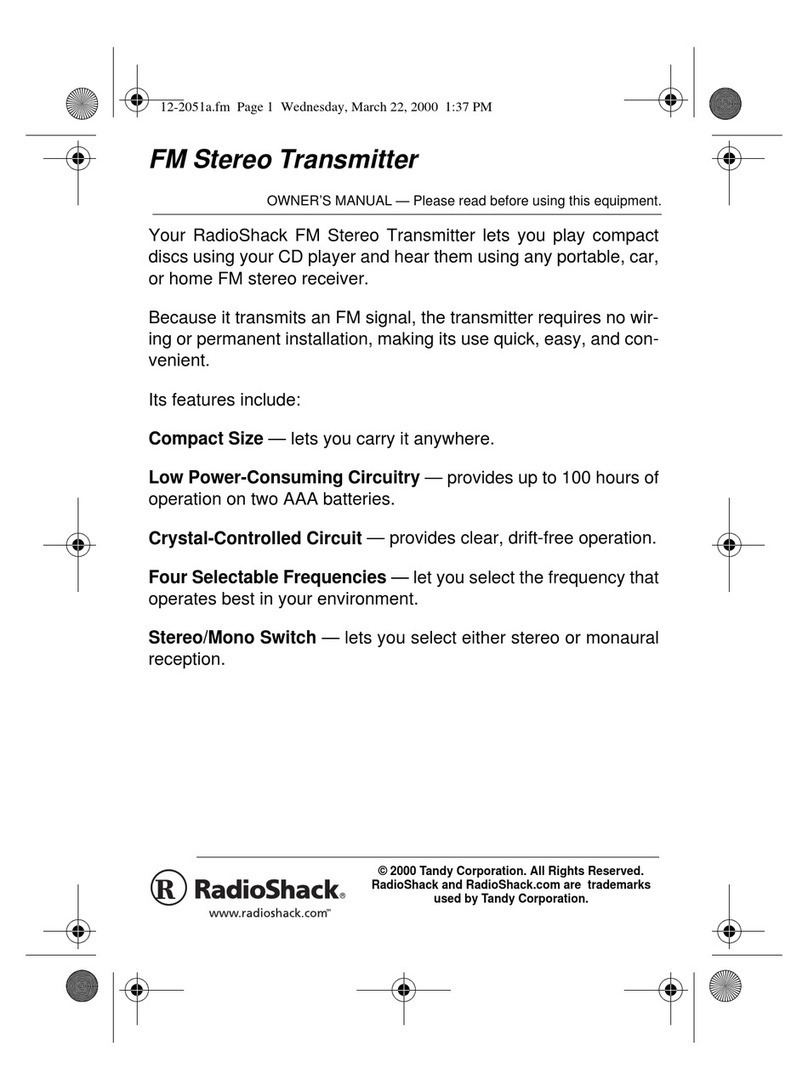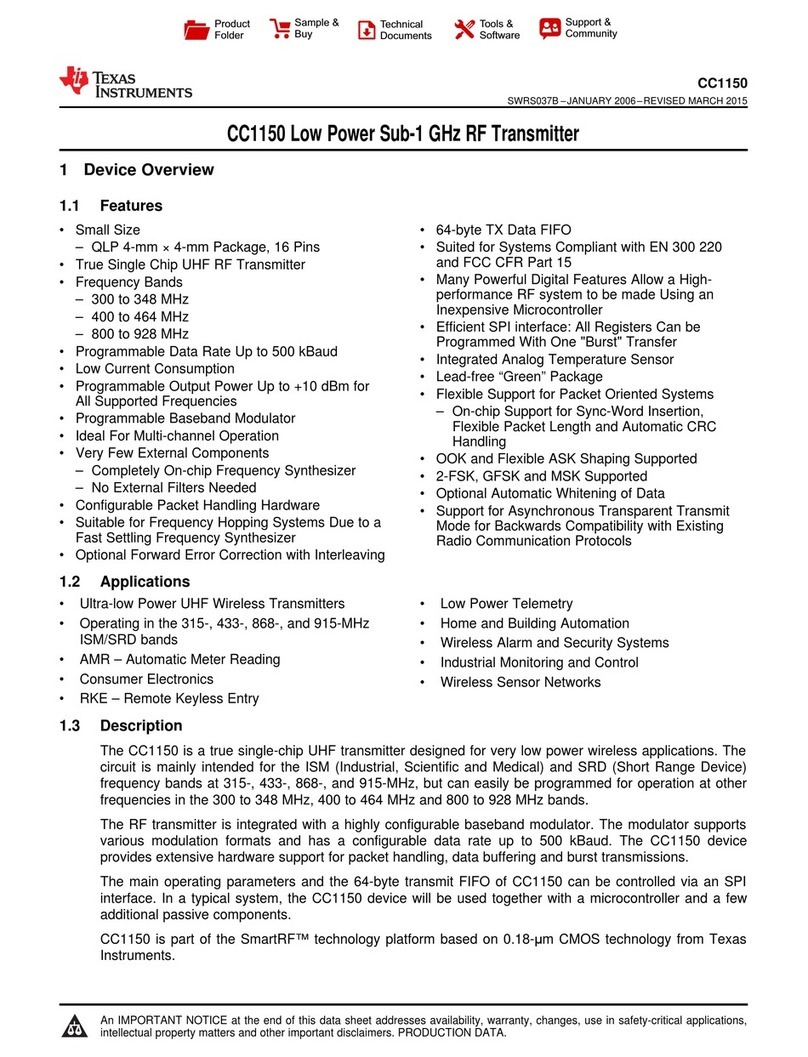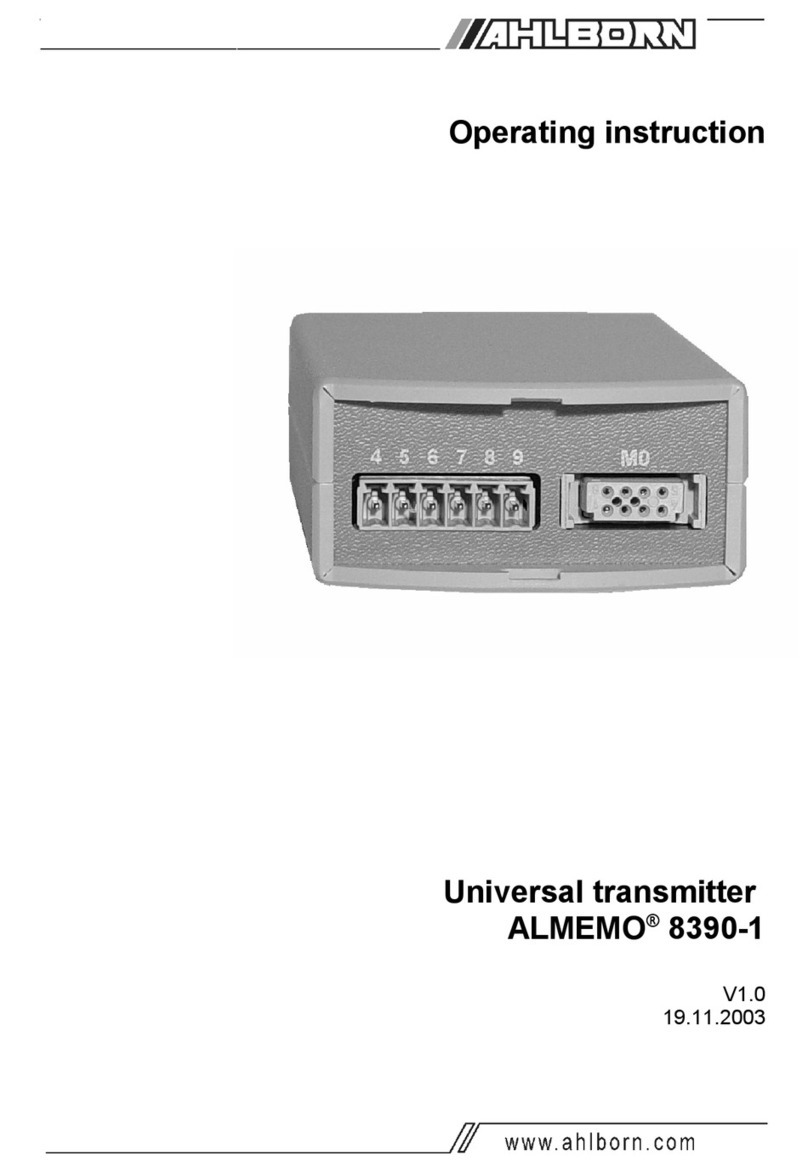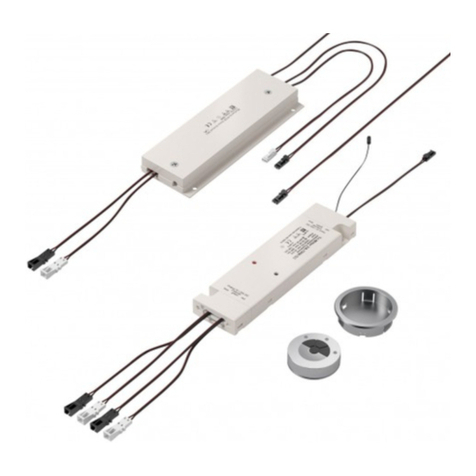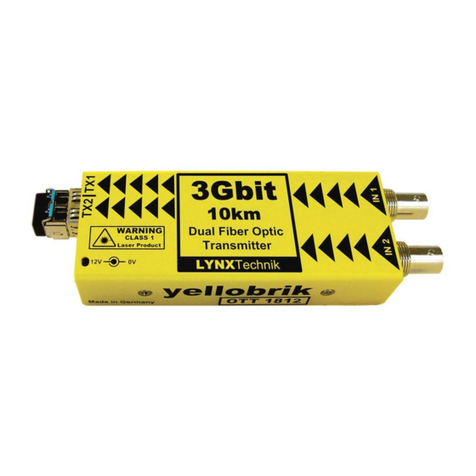T.E.M. A07B500S User manual

A07B500S manual
TECHNICAL , MAINTENANCE
AND INSTALLATION MANUAL
500 W FM TRANSMITTER
A07B500S
380245 R1

A07B500S manual
Pag. 2
OWNERS MANUAL
MAINTENANCE MANUAL
A07B500S FM TRANSMITTER
Printed : 21-01-2002 Rev. A
Cod. A07B500S
ACCORDING TO R&TTE RULES
ITALY RESTRICTIONS : “L’uso dell’apparato è soggetto a concessione
Potenza RF : 500 Watt
Canalizzazione 100 Khz ( solo mod. A07B500S ) “
All rights are strictly reserved
Reproduction or issue to third parties
in any form whatever
is not permitted without written authorization

A07B500S manual
Pag. 3
CONTENTS
CHAPTER 1 -SAFETY INSTRUCTIONS
1.1 Introduction----------------------------------------------------------------------------------------- 6
CHAPTER 2 -ELECTRICAL SPECIFICATIONS
2.1 Frequency and power------------------------------------------------------------------------------ 8
2.2 Modulation capability ----------------------------------------------------------------------------- 8
2.3 Characteristics in MONO------------------------------------------------------------------------- 8
2.4 Characteristics in STEREO----------------------------------------------------------------------- 9
2.5 SCA characteristics-------------------------------------------------------------------------------- 9
2.6 Readout on LCD display-------------------------------------------------------------------------- 9
2.7 Remote control------------------------------------------------------------------------------------- 9
2.8 Power supply and temperature range -----------------------------------------------------------10
2.9 Mechanical specifications------------------------------------------------------------------------10
2.10 Options---------------------------------------------------------------------------------------------10
2.11 Standards satisfied --------------------------------------------------------------------------------10
CHAPTER 3 -DESCRIPTION OF THE DEVICE
3.1 Main features--------------------------------------------------------------------------------------11
3.2 Available options ---------------------------------------------------------------------------------12
3.3 Block diagram-------------------------------------------------------------------------------------12
CHAPTER 4 -INSTALLATION
4.2 Unpacking and inspection------------------------------------------------------------------------17
4.2 Installation-----------------------------------------------------------------------------------------17
4.3 Power supply --------------------------------------------------------------------------------------17
4.4 Ground loops --------------------------------------------------------------------------------------18
4.5 Transmitter power up-----------------------------------------------------------------------------18
4.6 Transmitter settings-------------------------------------------------------------------------------18

A07B500S manual
Pag. 4
Connection diagram ---------------------------------------------------------------------------------------34
CHAPTER 5 -CIRCUITS DESCRIPTION
5.1 AUDIO-IN board ---------------------------------------------------------------------------------35
5.2 SINTD board--------------------------------------------------------------------------------------36
5.3 MBA board ----------------------------------------------------------------------------------------37
5.4 AGC board-----------------------------------------------------------------------------------------37
5.5 PWN board ----------------------------------------------------------------------------------------38
5.6 pw500-board---------------------------------------------------------------------------------------39
5.7 A15 board------------------------------------------------------------------------------------------39
5.8 LCDP board ---------------------------------------------------------------------------------------40
5.9 A500 module --------------------------------------------------------------------------------------40
5.10 DC250 board --------------------------------------------------------------------------------------41
CHAPTER 6 -ADJUSTMENTS
6.1 PWN - PW500 module –power supply --------------------------------------------------------42
6.2 A15 module–RF driver module ----------------------------------------------------------------43
6.3 DC-250 module –directionl coupler -----------------------------------------------------------44
6.4 MBP module –mother board--------------------------------------------------------------------45
6.5 A500 module –RF power amplifier------------------------------------------------------------48
CHAPTER 7 -MODULATION MEASUREMENTS
7.1 General informations -----------------------------------------------------------------------------49
7.2 Modulation peak analysis measurements ------------------------------------------------------50
7.3 Modulation power measurements---------------------------------------------------------------54
7.4 Considerations on the real measurements performed-----------------------------------------55
7.5 About FM syncronous----------------------------------------------------------------------------57
CHAPTER 8 -REMOTE CONTROL
8.1 Serial communication protocol------------------------------------------------------------------59
8.2 PC connection-------------------------------------------------------------------------------------60
8.3 COM1 ----------------------------------------------------------------------------------------------60

A07B500S manual
Pag. 5
CHAPTER 9 -INTERNAL AND REAR WIEW
9.1 Internal adjastments and settings -----------------------------------------------------------------66
9.2 Rear connections------------------------------------------------------------------------------------71
CHAPTER 10 -DIAGRAMS AND LAYOUTS
10.1 pwn board–main power supply------------------------------------------------------------------75
10.2 AUDIO-IN board - audio inputs -----------------------------------------------------------------79
10.3 LCDP board–display driver----------------------------------------------------------------------85
10.4 MBP board –mother board----------------------------------------------------------------------90
10.5 KEY board –key----------------------------------------------------------------------------------97
10.6 SINTD board–VCO oscillator----------------------------------------------------------------- 100
10.7 DMPX board–stereocoder--------------------------------------------------------------------- 104
10.8 AGC board–audio automatic gain control--------------------------------------------------- 108
10.9 MBP500 board–MBP / A500 connection ---------------------------------------------------- 112
10.10 A15 board–RF driver module----------------------------------------------------------------- 115
10.11 DC250 board–directional coupler------------------------------------------------------------ 118
10.12 A500 module–power amplifier --------------------------------------------------------------- 121
10.13 PW500 module–auxiliary power supply----------------------------------------------------- 124
10.14 LPF500 module–RF low pass filter---------------------------------------------------------- 130

A07B500S manual
Pag. 6
SAFETY INSTRUCTIONS
1.1 Introduction
T.E.M. has always managed to improve the safety standard if its transmitting and receiving
equipment. All produced systems are tested in compliance with international EN60950 and
EN60215 rules.
Obviously this is not sufficient to avoid any accident during the installation and the use of our
equipment in compliance with EN60215 rule, the radio transmitters and the auxiliary equipment
must be used by qualified technical staff only and T.E.M. declines any responsibility for damages
caused by an improper use or improper setting up performed by inexperienced staff, not qualified or
operating with instruments or tools not in compliance with safety set of rules.
WARNING
CURRENT AND VOLTAGE WORKING IN THIS EQUIPMENT ARE
DANGEROUS. THE STAFF MUST ALWAYS OBSERVE THE SAFETY
RULES, INSTRUCTIONS AND NORMS CONTAINED HEREIN.
WARNING
THE INSTRUCTIONS CONTAINED IN THIS MANUAL MUST BE READ
BEFORE SWITCHING ON OR SETTING THE TRANSMITTER
WARNING
ANY TRANSMITTER SERVICING, REPAIRING OR CHECKING
OPERATION REQUIRING THE OPENING OF THE TOP OR BOTTOM
COVER, MUST BE PERFORMED AFTER THE MAINS SUPPLY
DISCONNECTION WITHOUT REMOVING THE EARTH CONNECTION
WHICH THE EFFICIENCY MUST BE VERIFIED: THE CABLE MUST BE
IN GOOD CONDITIONS AND WELL CONNECTED.
WARNING
STAFF OPERATING UPON THE TRANSMITTER SYSTEM MUST NOT
BE TIRED: AFTER HEAVY WORKS OR CARRYING HEAVY
MACHINES BY HAND, IT IS NECESSARY TO RESPECT A PERIOD OF
REST BEFORE WORKING WITH SYSTEMS WHICH COULD HAVE
DANGEROUS ELECTRIC VOLTAGE IF THEY ARE NOT
DISCONNECTED.

A07B500S manual
Pag. 7
WARNING
SEVERAL SYMBOLS, INSIDE THE TYPICAL TRIANGLE SHOWING
DANGER, HAVE BEEN PRINTED ON SEVERAL TRANSMITTER
PARTS. ATTENTION SHOULD BE PAID, BECAUSE THERE COULD BE
THE DANGER DUE TO HOT SURFACES, ELECTRIC VOLTAGE
HIGHER THAN 50VOLT OR OTHER SPECIFIED DANGERS.
Certain devices (for example the RF final circuits mosfets) contain Beryllium Oxide BeO; these
components must not be broken, crashed or heated. This oxide passes through the common systems
of filtering, including the respiratory apparatus. The prolonged inhalation at high degrees causes
poisoning with respiratory apparatus paralysis, till death.
WARNING
ALL THE MODULES CONTAINING BeO ARE MARKED WITH THE
TRIANGULAR WARNING SYMBOL INDICATING THE NOTICE:
WARNING ! TOXIC HAZARD
THESE DEVICES CONTAIN BERYLLIUM OXIDE
OBSERVE SAFETY INSTRUCTIONS !
The staff in charge, besides being technically qualified, must have a practice of the first aid in case
of emergency or accident (reanimation, heart massage, mouth to mouth respiration, etc.).
Before going on with the operations to be performed, it is necessary to know the position of the
general electric switch and the one of the extinguishers, which are to be used very quickly if
necessary.

A07B500S manual
Pag. 8
A07A500S FM BROADCASTING
TRANSMITTER
ELECTRICAL SPECIFICATION
2.1 FREQUENCY -POWER
Frequency range ------------------------------------------------------------------------------ 87.6 to 107.9MHz
Frequency setting-----------------------------in 100KHz steps (model A07B500S-S have 10 Khz steps)
Internal setting mode-------------------------------------------------------------------------------------- by keys
External setting mode by remote control------------------------------------------- ( RS232-RS485-GSM )
Frequency stability -------------------------------------------------------------------------------- ±1000Hz/year
Frequency generation ---------------------------------------------------------------------------PLL synthesizer
Modulation type------------------------------------------------------------ direct VCO frequency modulation
Nominal frequency deviation--------------------------------------------------------------------------- ±75KHz
Deviation linearity in all frequency range --------------------------------------------------------------±0.2dB
Peak detector error------------------------------------------------------------------------------------------<0.1dB
RF output power ----------------------------------------------------------------------------------------0 to 500W
Power resolution setting --------------------------------------------------------------------------------------- 1W
Power control limit setting ---------------------------------------------------------------------------1 to 500W
Power control stability------------------------------------------------------------------------------------< 0.1dB
Reverse output power control limit ------------------------------------------------------------------- 1 to 99W
Reverse output power steps control-------------------------------------------------------------------------- 1W
Harmonics emission-------------------------------------------------------------------------------------- <-70dBc
Spurious emission ---------------------------------------------------------------------------------------- <-95dBc
Carrier reduction power ( carrier enable off ) --------------------------------------------------------- >70dBc
2.2 MODULATION CAPABILITY
MONO (left and right)-------------------------------------------------------------------------- 30Hz to 15KHz
STEREO (by internal stereo generator)------------------------------------------------------ 30Hz to 53KHz
SCA (two channels)----------------------------------------------------------------------------30Hz to 100KHz
COMPOSITE ----------------------------------------------------------------------MONO or STEREO + SCA
2.3 CHARACTERISTICS IN MONO
Signal input--------------------------------------------------------------------------------------------Left + Right
Input impedance --------------------------------------------------------------------- 600?(balanced) or 10k?
Unbalance rejection ----------------------------------------------------------------------------------------->40dB
Input level------------------------------------------------------------------------------------------- –6 to +12dBm
Pre-emphasis --------------------------------------------------------------------------------------------75 or 50?s
Audio frequency response (30Hz to 15KHz)--------------------------------------------------------- <0.15dB
Audio frequency response ( 19KHz to 100KHz) ------------------------------------------------------<-40dB
Modulation distortion ------------------------------------------------------------------------------------- <0.03%
Signal to noise ratio ----------------------------------------------------------------------------------------->90dB

A07B500S manual
Pag. 9
2.4 CHARACTERISTICS IN STEREO
Signal inputs------------------------------------------------------------------------------------------Left or Right
Input impedance --------------------------------------------------------------------- 600?(balanced) or 10k?
Unbalance rejection ----------------------------------------------------------------------------------------->40dB
Input level------------------------------------------------------------------------------------------- –6 to +12dBm
Pre-emphasis --------------------------------------------------------------------------------------------75 or 50?s
Audio frequency response (30Hz to 15KHz)--------------------------------------------------------- <0.15dB
Audio frequency response (19KHz to 100KHz)--------------------------------------------------------<40dB
Cross-talk between left and right channel --------------------------------------------------------------->50dB
Stereo separation between left and right channel------------------------------------------------------->50dB
Distortion at frequency deviation of 75KHz ---------------------------------------------------------- <0.03%
Distortion at frequency deviation of 100KHz--------------------------------------------------------- <0.03%
Signal to noise referred at deviation of 75KHz --------------------------------------------------------->85dB
Suppression of 38KHz-------------------------------------------------------------------------------------->80dB
Spurious suppression outside band -------------------------------------------.in according to ETS 300-384
Pilot reference for RDS encoder (19 Khz out) ----------------------------------------------------------- 1Vpp
2.5 SCA CHARACTERISTICS
Input (SCA1, SCA2) ---------------------------------------------------------------------------BNC unbalanced
Input impedance --------------------------------------------------------------------------------------------- 10K?
Frequency response (50KHz to 100KHz)---------------------------------------------------------------<0.1dB
Distortion -----------------------------------------------------------------------------------------------------<0.1%
Modulation capability------------------------------------------------------------------------------------0 to 10%
2.6 READOUT ON LCD DISPLAY (40x4 characters)
Forward power resolution ------------------------------------------------------------------------------------- 1W
Reverse power resolution------------------------------------------------------------------------------------0.1W
Modulation resolution----------------------------------------------------------------------------------------1KHz
Unbalance power resolution -------------------------------------------------------------------------------- 0.1W
Power amplifier voltage resolution --------------------------------------------------------------------------- 1V
Power amplifier current resolution--------------------------------------------------------------------------0.1A
Heatsink temperature resolution------------------------------------------------------------------------------1°C
2.7 REMOTE CONTROL
COM1 (front panel)directly to PC or by GSM---------------------------------------------------------RS232
COM2 (rear panel)to power amplifier-------------------------------------------------------------------RS232
COM3 (rear panel)for N+1 system or RNE remote control------------------------------------------RS485
Personal computer software------------------------------------------- National Instruments LAB-VIEW ®
Transmission protocol( COM1and COM2)-----------------------------------------------AES-EBU SP 490

A07B500S manual
Pag. 10
2.8 POWER SUPPLY AND TEMPERATURE RANGE
Operating voltage---------------------------------------------------------------------------------230VAC ±15 %
Operating voltage (Option D)-------------------------------------------------------------------115VAC ±10 %
Power Factor (Reactive and Harmonic Line Components) --------------------------------------------- >0.9
Line harmonic and flicker in according to--------------------------------------------------------- EN 61000
Line power--------------------------------------------------------------------------------------------------<1KVA
Nominal temperature range ---------------------------------------------------------------------------5° to 45°C
Operating temperature range----------------------------------------------------------------------- -10° to 50°C
Storage temperature range------------------------------------------------------------------------- -40° to 50°C
2.9 MECHANICAL SPECIFICATION
19” rackmount---------------------------------------------------------------------------------- 485x135x530mm
Weight---------------------------------------------------------------------------------------------------------- 16Kg
2.10 OPTIONS
Option A ------------------------------------------------------------------------------------------Stereo generator
Option B------------------------------------------------------------------------Automatic Audio Level Control
Option C---------------------------------------------------------Remote Control (directly to PC or by GSM)
Option D ----------------------------------------------------------------------------- 115 Vac Operating Voltage
Frequency steps-------------------------------------------------------------------------10 Khz frequency steps
2.11 STANDARDS COMPLYS ( R&TTE )
Electrical characteristics--------------------------------------------------------------------------- ETS 300-384
EMC characteristcs------------------------------------------EN 61000-3-3 EN 61000-3-2 ETS 300-447
Safety characteristics---------------------------------------------------------------------EN-60950–EN-60215

A07B500S manual
Pag. 11
GENERAL DESCRIPTION
3.1 Main features
A07B500S is a FM band broadcasting transmitter with modern conceiving and technology,
which by a simple design produces an output radio signal with high characteristics of quality,
reliability and security.
The simple manufacturing obtained with a hi integration of functions, has allowed to create
a machine with few controls and connections. Most printed circuits are multilayer with a surface
mounting technology component assembling. The eventual repairing can be done by simply
changing the fault involved board, without searching the defective component.
One of the most important characteristics is done by the high quality of the frequency
modulation and the high signal-to-noise ratio; moreover, the modulation is typically constant within
0.1dB throughout the whole FM band (88–108MHz ). A proper peak detector allows to perform
both traditional modulation measurements (usual bar-graph with peak), and modulation and power
modulation ones with long observation periods (even with many hours or days) according to the
latest international regulations, which properly cared to fix a limit scientifically measurable to the
peak and modulation power (CEPT 54-01).
An particular audio circuit can control the input audio level with a ±6dB dynamics referred
to the nominal value: this can be extremely useful when the audio signal level is not fixed or when
this one can be subject to fluctuations (usually very slow) due to thermal driftsbad systems
maintenance, possible damages along radio link paths etc. A proper board can be inserted to obtain
this function and a proper microprocessor follows constantly the modulation value correcting
through proper algorithms, implemented in its memory, the value of the modulator gain, keeping
this way the modulation very close to the maximum allowed value. The corrections take place at
very long periods of time; the board does not perform the audio compressing-limiting functions, but
just compensates possible drifts occurring on the systems carrying the audio channel before entering
in the FM transmitter. No measurable phase or amplitude distortion is introduced in the modulation
when the automatic gain control circuit is enabled. In addition an alarm which switches the power
off in case of modulation absence can be inserted since the unmodulated carrier transmission is
forbidden in many countries, with no chance to identify the radio.
The transmitter can be set like a modern signals generator so the output power is completely
managed by a device which guarantees that the values of forward power, reflected power,
maximum output power versus the temperature and loading conditions, are always the ones set or
the ones allowed by maximum limits. A directional wide band coupler with remarkable directivity
and large on board memory allows to obtain a power accuracy worthy of a good measurement
instrument.
All parameters (frequency, levels, mono/stereo, pre-emphasis, power) can be set by the
keyboard and stored in E2PROM in order to be kept even without electric supply. A great number of
events can be stored: each alarm is distinguished by a starting and an ending alarm date. The
controlled parameters are: modulation absence, heatsink temperature, mains supply voltage, RF
power final stage voltage and current, main oscillator fault.

A07B500S manual
Pag. 12
Besides the keyboard, the transmitter can be remotely controlled in different ways. A
personal computer can be connected as monitor to the DB9 socket placed on the front panel and by
a special program, to be load easily on the PC, all the transmitter parameters can be set and seen.
Furthermore it’s possible to perform all the modulation analysis provided by the CEPT 54-01
regulations and create the related graphics which can be stored as a file in the PC.
A second RS232 port placed in the transmitter rear part can be connected to the power
amplifier connected in series to the exciter, thus allowing the power data display on the same PC
connected to the front RS232.
A third RS485 port placed in the rear part can be connected to a MODEM which is
connected to the phone line thus assuring the transmitter telecontrol, remotely or from the studio.
The same RS485 port can be used for the connection N+1 of more transmitters (max 16). In
this case a transmitter acts as a “joker”, so it replaces the faulty equipment, automatically adapting
to all its parameters. Each transmitter is also provided with an output port (IN/OUT) suitable to
drive the antenna cable multiplexer and the one for the input audio signals switching.
3.2 Available options
a) STEREO ENCODER : additional board allowing the internal encoding of the
stereophonic signal
b) AGC : additional board allowing a frequency modulation
control
c1) REMOTE CONTROL : software for the PC or GSM connection
c2) N+1 system : software to obtain N+1 system
c3) 1+1 system : software to obtain 1+1 system
d) Line Voltage : 115 Vac
Model A07B500S-S have 10 Khz frequency steps
3.3 Block diagram
The transmitter can be modulated by five different audio signal.
The first two ones are made by monophonic left and right channels, which can be balanced
or unbalanced. The input dynamic goes from –6 to +12dBm with an input impedance which can be
high or low. On these channels either the European or American pre-emphasis value can be
inserted. A low pass filter on each of the two inputs assures a good attenuation of audio frequencies
higher than 15KHz which could interfere, in case of stereophonic transmission, with higher band
and with la subcarrier of the Multiplex signal; the out-of-band attenuation of the filter is not
excessive in order not to increase then phase distortion (group delay) of the in band audio signal:

A07B500S manual
Pag. 13
60–70dB of attenuation, even with 0.1dB of amplitude linearity up to 15KHz, unavoidably
creates a
phase distortion on the analogue signal that an experienced ear can perceive. Right or left signals
can be combined to generate monophonic transmission (should you only have one of the two
signals, it will be necessary to externally put in parallel the two inputs); in case of stereophonic
transmission, the two channels are fed inside the stereo code board.
The mono signal or the stereo one, thus obtained, is combined with the other three possible
input audio signals: an external Multiplex signal and two SCA signals, one of which can be the
RDS one, which can be synchronized with a 19KHz one connected on the IN/OUT rear connector.
The composite signal can enter the AGC board, which has the task to check the its amplitude
and consequently to keep the modulation at the correct value, or it can follow its path and enter into
the frequency modulator after having passed through a limiter circuit (CLIPPER). This circuit must
became active just in cases of faults of previous circuits or in case of mistake in the setting of the
low frequency input nominal levels; this is to avoid to interfere with the adjacent channels. For not
activating this “fuse”, which produces remarkable distortions on the modulation, it is necessary to
take all proper cautions, that is the use of external compressor-limiters or by inserting the internal
AGC circuit which protects a lot against damages and drifts.
The oscillator, directly modulated by the composite signal, covers the whole FM band and
it’s synthesized in steps of 10KHz . The reference frequency is obtained by a 10MHz crystal ,whilst
the output frequency is set by the main microcontroller. The oscillator phase noise is very good and
it is in compliance with ETSI 300-384 regulations (<-145dBc for a shifting of 1MHz from the
carrier). The modulation linearity is typically contained within 0.1dB without complicated
corrections.
The RF final power circuit is wide band and it provides 500W RF output controlled with
high accuracy; directional coupler has a directivity higher than 25dB on the whole band and an error
which is lower than 0.2dB, it is also compensated in temperature and totally shielded.
The power supply is of a switching type and it gives the four essential voltages, all obtained
with this technique. The mechanical position of the power supply and the final circuits of RF power
allow to obtain a vent flu just for cooling of the involved circuits, obtaining this way a really
remarkable efficiency of that function. In normal running conditions, when the transmitter is
working in a full power at environmental temperature, the radiator temperature is lower than 50°C,
whereas the other circuits temperature does not exceed 30°C. No components are involved with the
air flow, so it isn’t requested a filter on the aspiration fan, which replacing is rather simple. The
power supply is completely shielded both for internal circuits and for its unavoidable emissions
toward the outside.
Data displaying and setting is obtained by a board which is placed directly on the front panel
containing a microprocessor, memory, keyboard, LCD display. The displaying area is wide so
allowing to display and set needed data in a very easy way, thus making the transmitter-user
technician interaction extremely user friendly.
It’s possible to protect the transmitter input and output parameter settings with a password,
while all measurements can be done by whoever without interfering on its operation.

A07B500S manual
Pag. 14
Two communication RS232 ports and a RS485 port can make possible the communication
between the transmitter and a PC, with the power amplifier and the driver exciter, or with a modem
or GSM connected with the telephone line.
Maintenance or repairing of damages do not require the soldering use for the replacement of
the parts to be changed; only six flat cables link all different boards.

A07B500S manual
Pag. 15
A07B500S -TRANSMITTER BLOC DIAGRAM

A07B500S manual
Pag. 16
A07B500S -POWER SUPPLY BLOC DIAGRAM

A07B500S manual
Pag. 17
INSTALLATION
4.1 Unpacking and inspection
Immediately, after the transmitter has been delivered, please carefully check the package to
verify possible damages caused by shipment. Should be found some damages, please
immediately contact the T.E.M. dealer.
It is recommended to keep the original package for a future shipment due to, for instance, repairing
or setting. A return with a package which is different from the original one will make the warranty
rights lost.
4.2 Installation
The transmitter A07B500S is composed of a 19 inches width rack which takes 3 units in height in a
vertical rack mount.
It is recommended to use 4 fixing plastic washers in order to avoid damages to the front panel
varnishing. We remind to carefully connect the earth both to the transmitter and to the rack mount-
never disconnect it without having switched the supply voltage off by the mains switch.
Design has considered the new rules concerning the electromagnetic compatibility so there aren’t
problems to locate systems CE marked nearby.
4.3 Power supply
AC power supply at 50/60Hz can be at 230VAC or 115VAC( opz.D )
The switching on control is placed for security reasons on the rear panel with the protection fuse,
which must have the value 6A for the higher voltage and 12A for the lower one and it must be a fast
type.
BEFORE SWITCHING THE TRANSMITTER ON, MAKE SURE
THAT THE POWER SUPPLY IS CORRECT AND CONNECT
THE RIGHT LOAD OR ANTENNA!

A07B500S manual
Pag. 18
4.4 Ground loops
Sometimes connecting various ground sockets having different potentials may produce some
unwanted loops, which may create hum in the modulation: in this case it is essential to firstly
identify the origin of these currents, which normally spring from the antenna ground, mains supply
ground or from the input low frequency signals ground.
If the inconvenience can not be removed, the balanced input of the two channels LEFT and RIGHT
can be used, thus obtaining common mode noise rejection of 40dB approximately.
All the inputs and outputs are protected by diodes against the electrostatic discharges and they are
provided with filters against the RF noise ( in according to EN-61000 )
4.5 Transmitter power up
After making sure about the proper earth socket connection, correct power supply and connection of
the load on the antenna output, the equipment can be switched on.
If there is the first switching on, problems of wrong setting can’t occur since the transmitter
contains some standard values and the output power will be set to 1W, in order to avoid any
problem of interference or driving for possible following amplifiers. The set values will be
displayed and changed according to your need before the RF power is emitted from the transmitter.
The equipment is provided with a memory which holds all settings even when the electric supply is
off, however it is recommended to set the power at 1 W when uninstalling the transmitter itself to
avoid any problem in case of a new setting up.
REMEMBER THE PASSWORD !
To enter the setting menu, knowing the password is mandatory. It’s a four digits number written on
the transmitter delivery document. Should it be forgotten, it will be possible to perform the set up
by setting the Z2 jumper placed on the board LCDP (vertical board placed behind the rear panel) on
the soldering side; the jumper is easy to identify through the close capture: PASSWORD ON/OFF.
In this case, this operation must be performed with the equipment switched off and it requires also
the opening of the top cover which, at ended operation, must be closed again with all its screws; it is
essential to use a proper cross point screwdriver.
4.6 Transmitter settings
4.6.1 At the switching on, the display will glow giving for few seconds the
following screen shot

A07B500S manual
Pag. 19
4.6.2 On the screenshot the options contained in the transmitter and the hour of the last switching
on will also appear and it will correspond to the current hour and date. If one finds out a
discrepancy between the hour given and the current one, it will be necessary to correct the error in
the clock setting.
If this screenshot is accessed from another menu, the indication LAST POWER ON will show the
last switching on date and it will be able to give the operator some indications about accidental
switching off.
4.6.3 If all the indications are right, after a while the first page will be shown;
which with the second one will contain all the most important measurements of the transmitter:
The display is explanatory enough

A07B500S manual
Pag. 20
FREQUENCY is the output frequency set in MHz
FORW. PW is the forward output RF power
REFL. PW is the input reflected power on the RF connector
LOCK ON shows that main oscillator is locked the programmed frequency
MODULATION shows the modulation value of the COMPOSITE signal
TEMPERATURE shows the radiator temperature value of the RF power final mosfets
250W BAL shows the unbalance power of the two final coupled amplifiers
Moreover, in the lower part of the display, at the middle there is the indication of the number of
alarms eventually set in the memory which have taken place after the last clearing of the memory.
These ones will be displayed automatically by a continuous enter of PAGE UP.
If one enters PAGE DOWN in this screen shot, the previous one returns and it will be possible to
see once again the date of the last switching on or to change the mains supply voltage value.
If an alarm is on, always in the same position of the display, the intermitting message ALARM will
be pointed out.
4.6.4 By entering PAGE UP, it’s possible to see the second screen shot of the most
important measures:
AUDIO LEVEL is the nominal audio signal set on the setting window placed on the
rear panel: if this value doesn't match to the needed one, it’s possible
to choose 0 , 4.1 , 6dBm or, by placing the jumper on var, it’s
possible to choose a value between –6 and +12dBm.
PREEMPH. 75 is the chosen pre emphasis value, always on the rear window, also the
value 50µs can be selected; the inclusion or the disabling may be
performed by the keyboard in a following screen shot.
AUDIO shows whether the transmitter is set to mono or stereo.
CARRIER EN shows if the output power is enabled either by a keyboard command
or by an external command through the IN/OUT rear connector.
PA VOLTAGE is the supply voltage of the RF power final mosfets.
PA CURRENT is the voltage drained by the mosfet final power.
MAX PW SET is the maximum power value which can be programmed by the
keyboard in the screen shot Forward PW adj (1–500W) to avoid
accidental over drivings of the following amplifiers.
RFL PW SET is the maximum allowed output reflected power. Should this limit be
reached, the direct power will be reduced to keep constant the limit
value of the reflected power (1-50W)
Table of contents
Popular Transmitter manuals by other brands
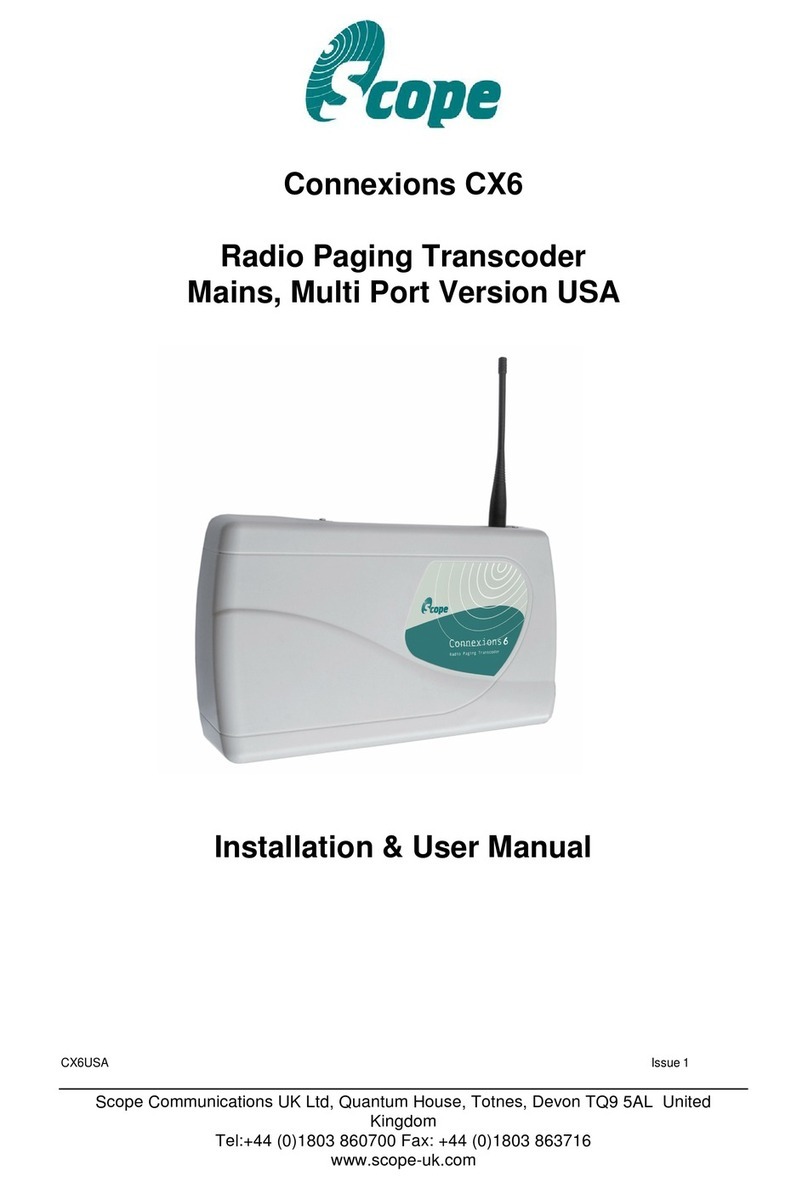
scope
scope Connexions CX6USA Installation & user manual
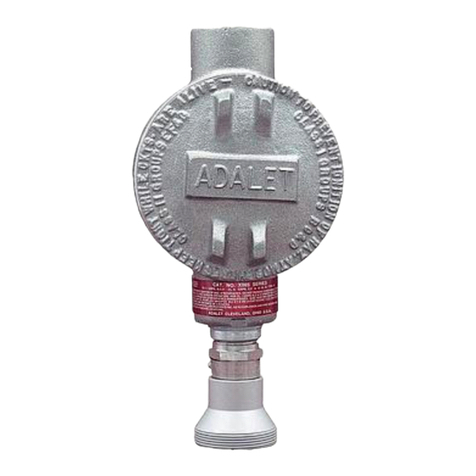
RKI Instruments
RKI Instruments 65-2330RK Operator's manual

LEYBOLD
LEYBOLD THERMOVAC TTR 91 N operating manual
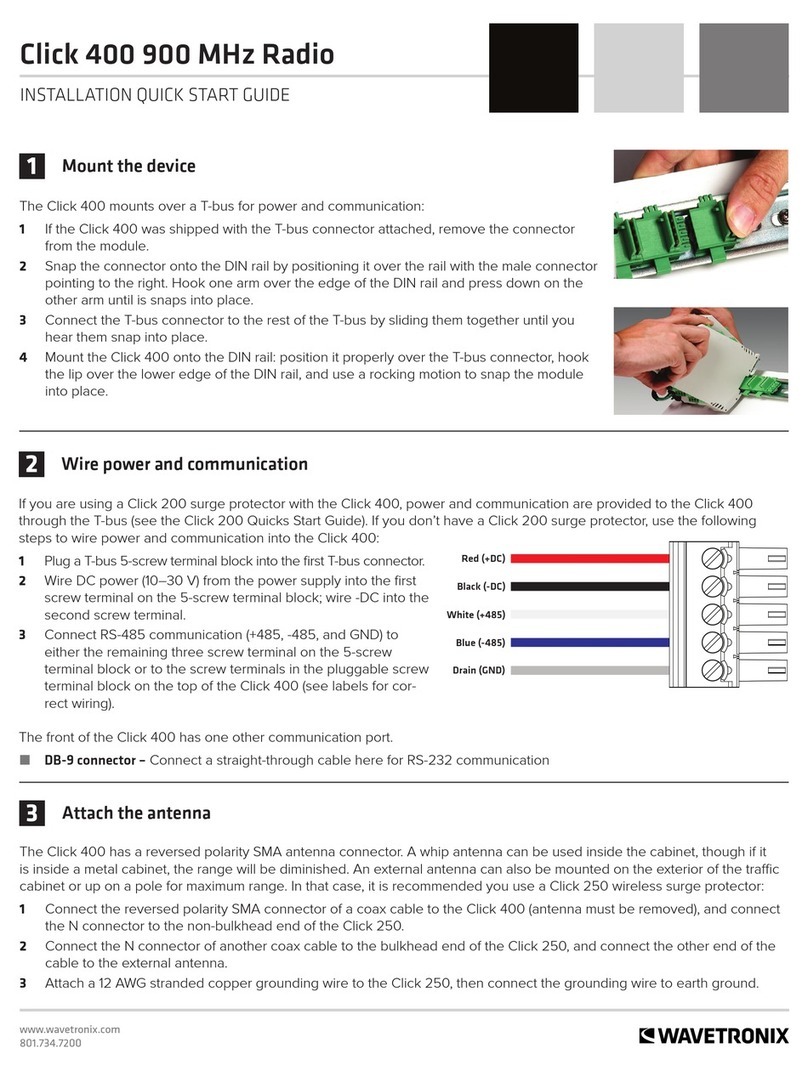
Wavetronix
Wavetronix Click 400 Installation & quick start guide

Vaisala
Vaisala DRYCAP DMT345 user guide

Johnson Controls
Johnson Controls GS3000 installation guide


